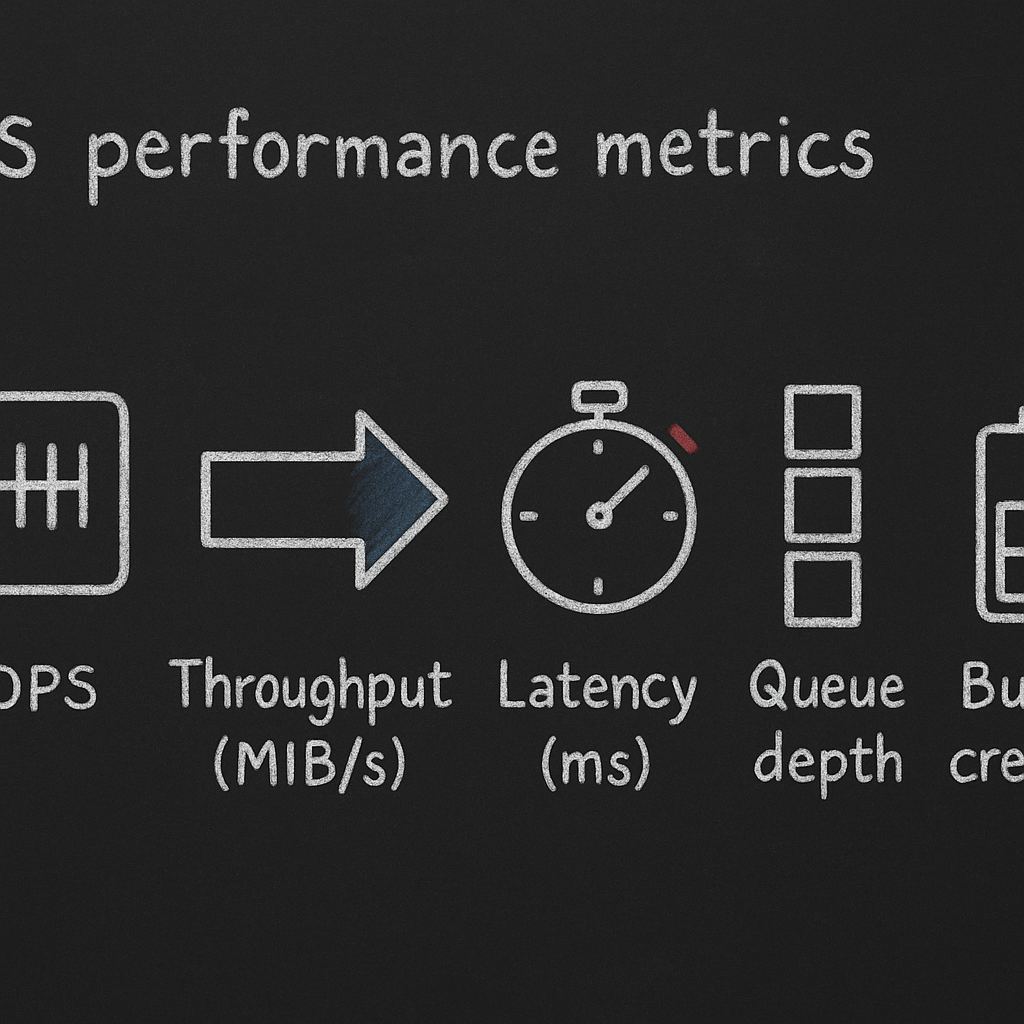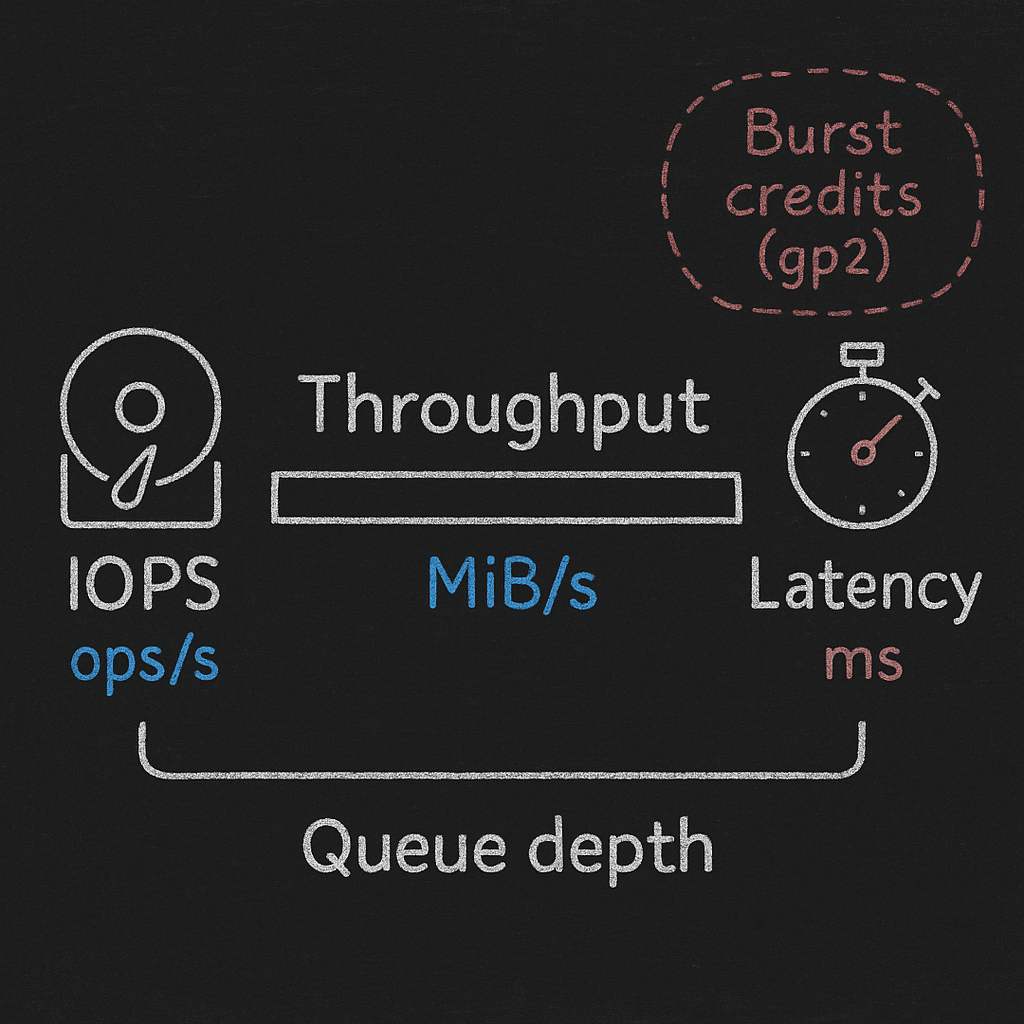EBS Performance Benchmarking and Optimization: A Practical Guide for AWS Engineers
Ever wondered why your AWS cloud workloads crawl despite paying premium rates for EBS volumes? You’re not alone. For many DevOps teams, achieving the right balance between Amazon EBS performance and cost efficiency feels like chasing a moving target. This guide cuts through the complexity with actionable benchmarking methods, troubleshooting approaches, and optimization strategies that deliver measurable results.
Understanding EBS Performance Fundamentals
Before launching any benchmark, you need to understand what metrics actually matter for EBS performance:

- IOPS (Input/Output Operations Per Second): The number of read/write operations per second, critical for transactional workloads like databases
- Throughput: Measured in MiB/s, representing data transfer volume, important for large sequential workloads
- Latency: Time to complete an I/O operation, typically in milliseconds
- Queue Depth: Number of pending I/O requests to a volume
- Burst Credits: Applicable to some volume types like gp2, allowing temporary performance above baseline
Your actual performance is largely determined by configuration choices rather than hardware limitations. As Hykell’s research shows, different volume types serve different purposes:
- gp3: Baseline 3,000 IOPS and 125 MiB/s regardless of size with no burst credits
- io2/io2 Block Express: For consistent, low-latency I/O up to 256,000 IOPS
- st1: Designed for sequential workloads with up to 500 MiB/s throughput
- sc1: Lowest cost option for infrequently accessed data
Setting Up Your EBS Benchmark Environment
Recommended Benchmark Procedure

- Launch an EBS-optimized instance in your target Availability Zone
- Create new EBS volumes specifically for testing (never benchmark production volumes)
- Attach volumes to your instance
- Configure and mount the block device
- Install benchmarking tools
- Run your benchmarks
- Delete test volumes and terminate the instance when done
Using FIO for Benchmarking
Flexible I/O Tester (FIO) is the industry standard for EBS benchmarking. Here’s a basic script to get started:
# Random read testfio --name=random-read --directory=/path/to/test --rw=randread --bs=4k --size=4g --numjobs=1 --time_based --runtime=180 --group_reporting
# Random write testfio --name=random-write --directory=/path/to/test --rw=randwrite --bs=4k --size=4g --numjobs=1 --time_based --runtime=180 --group_reporting
# Sequential read testfio --name=sequential-read --directory=/path/to/test --rw=read --bs=1m --size=4g --numjobs=1 --time_based --runtime=180 --group_reporting
# Sequential write testfio --name=sequential-write --directory=/path/to/test --rw=write --bs=1m --size=4g --numjobs=1 --time_based --runtime=180 --group_reportingWhen benchmarking, follow these best practices identified in Hykell’s cloud performance benchmarking guide:
- Establish clear baselines before optimization
- Use consistent testing environments (same instance types, same AZ)
- Control for variables like time of day and concurrent workloads
- Adopt industry standards like TPC-DS for big data workloads
- Schedule regular benchmarking cycles (quarterly reviews are common)
Interpreting Benchmark Results
After running benchmarks, focus on these key insights:
- IOPS Achieved vs. Provisioned: Are you getting what you’re paying for?
- Latency Distributions: Examine P95/P99 latencies, not just averages
- Queue Depth: High queue depth indicates performance bottlenecks
- Throughput Consistency: Check for variations in throughput over time
Common benchmark interpretation pitfalls include:
- Ignoring the initialization effect (first-write penalty)
- Not accounting for burst credits being depleted
- Overlooking instance-level bandwidth limitations
- Testing with inappropriate I/O patterns for your workload
Troubleshooting EBS Performance Issues
When faced with poor EBS performance, follow this systematic approach:
-
Check CloudWatch Metrics: Review VolumeReadOps, VolumeWriteOps, VolumeQueueLength and other AWS EBS performance metrics
-
Analyze Bottlenecks:
- For high latency: Check if you’re exceeding provisioned IOPS/throughput
- For time-based degradation: Verify if burst credits are depleted
- For random performance issues: Check for “noisy neighbor” effects
-
Verify Instance Settings:
- Confirm you’re using an EBS-optimized instance
- Check if instance bandwidth limits are restricting EBS performance
- Verify the instance type supports your EBS performance requirements
-
Review Volume Configuration:
- Verify initialization status (pre-warming may be needed)
- Check if you’re hitting single-volume performance limits
- Ensure proper alignment with workload patterns
Optimizing EBS Performance
Based on benchmark results, apply these optimization strategies:
Volume Type Selection
-
Standardize on gp3 for most volumes and migrate off gp2 to eliminate credit risk and save approximately 20% per GiB, as recommended by Hykell’s optimization team.
-
Use io2 only where latency SLAs demand it; keep non-critical and dev/test environments on gp3.
-
Tier cold/sequential data to st1/sc1 or S3 to cut costs per GiB dramatically.
Instance and EBS Bandwidth Alignment
-
Align EC2 instance EBS bandwidth with aggregate volume needs and upgrade instances when storage-bound.
-
Stripe volumes when exceeding single-volume ceilings, but account for failure domains and backups.
-
Enable EBS optimization on your instances to ensure dedicated bandwidth for EBS traffic. As noted in AWS EC2 performance tuning, this is critical for consistent performance.
Performance Tuning Checklist
-
Match volume type to workload pattern:
- OLTP → io2 or gp3 with high IOPS
- Data warehousing → st1 or gp3 with high throughput
- Mixed workloads → gp3 with balanced settings
-
Right-size capacity, IOPS, and throughput based on observed metrics, not guesswork.
-
Tune OS and application I/O patterns:
- Adjust read-ahead settings for sequential workloads
- Optimize I/O queue depths at the application level
- Use modern Linux kernels with NVMe optimizations
-
Monitor with CloudWatch and set alerts for queue depth and latency issues.
Cost-Effective Performance Strategies
The goal isn’t just performance—it’s optimal performance at the right cost:
-
Right-sizing alone can reduce costs by up to 50% in some cases, especially for organizations that initially over-provisioned.
-
A 1TB volume using only 500GB represents a 50% cost inefficiency that can be eliminated.
-
Automated platforms can deliver up to 40% savings with performance intact through continuous right-sizing of capacity, IOPS, and throughput.
-
Monitor key CloudWatch EBS metrics regularly:
- VolumeReadOps/WriteOps
- VolumeReadBytes/WriteBytes
- VolumeTotalReadTime/WriteTime
- BurstBalance (for gp2)
- VolumeQueueLength
- ThroughputPercentage
-
Use AWS Compute Optimizer to identify optimization opportunities. It examines historical usage data and often identifies 20-30% of volumes as candidates for optimization.
Monitoring and Continuous Optimization
Set up a monitoring strategy that includes:
- CloudWatch Dashboards with key EBS metrics
- CloudWatch Alarms for performance thresholds
- Regular benchmark cycles to validate performance over time
- Automated remediation for common issues
For optimal results, consider implementing cloud native application monitoring with tools that can continuously adjust resources based on actual usage patterns.
Practical Application: Benchmark-Driven Optimization
Consider this real-world scenario:
A financial services company was experiencing latency spikes during market opening hours. Benchmarks revealed their gp2 volumes were depleting burst credits, causing unpredictable performance. By:
- Migrating to gp3 volumes with consistently provisioned IOPS
- Adjusting instance types to ensure sufficient EBS bandwidth
- Implementing volume striping for databases exceeding single-volume limits
They achieved 40% better performance at 15% lower cost, while eliminating the unpredictable performance issues.
Taking Action on Your EBS Performance
Understanding and optimizing EBS performance is a continuous process that requires regular benchmarking, monitoring, and adjustment. By following the strategies outlined in this guide, you can ensure your AWS workloads achieve optimal performance while controlling costs.
Ready to automate this process? Hykell can help you identify the perfect balance between performance and cost, delivering up to 40% savings on your AWS storage costs while maintaining or improving performance. Our automated platform continuously monitors and adjusts your EBS configuration based on actual usage patterns, ensuring you never overpay for performance you don’t need.
